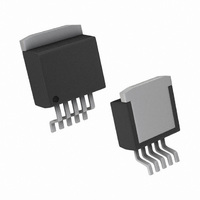LM2587S-3.3/NOPB National Semiconductor, LM2587S-3.3/NOPB Datasheet - Page 24

LM2587S-3.3/NOPB
Manufacturer Part Number
LM2587S-3.3/NOPB
Description
IC REG SIMPLE SWITCHER TO-263-5
Manufacturer
National Semiconductor
Series
SIMPLE SWITCHER®r
Type
Step-Up (Boost), Flyback, Forward Converterr
Datasheet
1.LM2587S-ADJNOPB.pdf
(28 pages)
Specifications of LM2587S-3.3/NOPB
Internal Switch(s)
Yes
Synchronous Rectifier
No
Number Of Outputs
1
Voltage - Output
3.3V
Current - Output
5A
Frequency - Switching
100kHz
Voltage - Input
4 ~ 40 V
Operating Temperature
-40°C ~ 125°C
Mounting Type
Surface Mount
Package / Case
D²Pak, TO-263 (5 leads + tab)
For Use With
551011367-061 - BOARD WEBENCH LM2577,LM2585/87LM2587EVAL - EVALUATION BOARD FOR LM2587
Lead Free Status / RoHS Status
Lead free / RoHS Compliant
Power - Output
-
Other names
*LM2587S-3.3
*LM2587S-3.3/NOPB
LM2587S-3.3
*LM2587S-3.3/NOPB
LM2587S-3.3
Available stocks
Company
Part Number
Manufacturer
Quantity
Price
Company:
Part Number:
LM2587S-3.3/NOPB
Manufacturer:
National Semiconductor
Quantity:
135
www.national.com
OUTPUT VOLTAGE LIMITATIONS
The maximum output voltage of a boost regulator is the max-
imum switch voltage minus a diode drop. In a flyback regula-
tor, the maximum output voltage is determined by the turns
ratio, N, and the duty cycle, D, by the equation:
The duty cycle of a flyback regulator is determined by the fol-
lowing equation:
Theoretically, the maximum output voltage can be as large as
desired—just keep increasing the turns ratio of the trans-
former. However, there exists some physical limitations that
prevent the turns ratio, and thus the output voltage, from in-
creasing to infinity. The physical limitations are capacitances
and inductances in the LM2587 switch, the output diode(s),
and the transformer—such as reverse recovery time of the
output diode (mentioned above).
NOISY INPUT LINE CONDITION)
A small, low-pass RC filter should be used at the input pin of
the LM2587 if the input voltage has an unusual large amount
CIRCUIT LAYOUT GUIDELINES
As in any switching regulator, layout is very important. Rapidly
switching currents associated with wiring inductance gener-
ate voltage transients which can cause problems. For minimal
inductance and ground loops, keep the length of the leads
and traces as short as possible. Use single point grounding
or ground plane construction for best results. Separate the
signal grounds from the power grounds (as indicated in
44). When using the Adjustable version, physically locate the
programming resistors as near the regulator IC as possible,
to keep the sensitive feedback wiring short.
HEAT SINK/THERMAL CONSIDERATIONS
In many cases, no heat sink is required to keep the LM2587
junction temperature within the allowed operating range. For
V
OUT
≈
N × V
IN
× D/(1 − D)
FIGURE 44. Circuit Board Layout
Figure
24
of transient noise, such as with an input switch that bounces.
The circuit in
with the capacitor placed from the input pin to ground and the
resistor placed between the input supply and the input pin.
Note that the values of R
are good enough for most applications, but some readjusting
might be required for a particular application. If efficiency is a
major concern, replace the resistor with a small inductor (say
10 μH and rated at 100 mA).
STABILITY
All current-mode controlled regulators can suffer from an in-
stability, known as subharmonic oscillation, if they operate
with a duty cycle above 50%. To eliminate subharmonic os-
cillations, a minimum value of inductance is required to en-
sure stability for all boost and flyback regulators. The
minimum inductance is given by:
where V
in the Characteristic Curves.
each application, to determine whether or not a heat sink will
be required, the following must be identified:
1) Maximum ambient temperature (in the application).
2) Maximum regulator power dissipation (in the application).
3) Maximum allowed junction temperature (125°C for the
LM2587). For a safe, conservative design, a temperature ap-
proximately 15°C cooler than the maximum junction temper-
ature should be selected (110°C).
SAT
is the switch saturation voltage and can be found
Figure 43
demonstrates the layout of the filter,
IN
and C
IN
shown in the schematic
1231629












